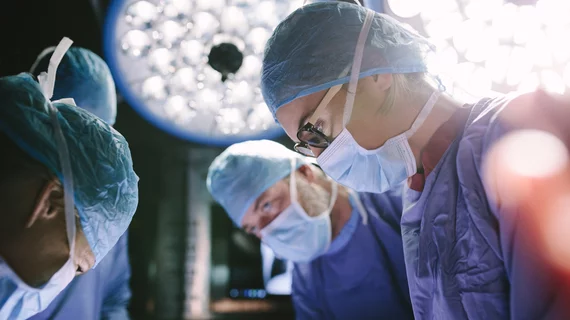Using the "no-touch" vein harvesting technique during coronary artery bypass grafting (CABG) procedures is associated with a lower risk of vein graft occlusion and better patient outcomes, according to new data published in Circulation.
The no-touch technique, developed in Sweden in the 1990s, involves surgically removing the vein along with a thin layer of surrounding tissue. With this added protection, the vein is believed to be less likely to spasm and close; as a result, there is no need to keep it open with saline.
The study's authors analyzed data from 2,655 adults in China who underwent CABG at one of seven cardiac surgery centers from April 2017 to June 2019.
In the study, 1,313 patients had their veins harvested using a conventional technique; the no-touch technique was used on 1,325 patients. Seventy-eight percent of patients in both groups were men, and the mean patient age was 61 years old.
According to the authors, the study was the first large, multicenter comparison of the two vein harvesting techniques.
Overall, the newer technique was associated with multiple benefits. In CT scans of the coronary arteries after three months, 2.8% of the grafts had become blocked in the no-touch group, compared with 4.8% of the conventional group. In CT scans taken after 12 months, on the other hand, 3.7% of the grafts had become blocked in the no-touch group, compared with 6.5% of the conventional group.
The no-touch technique also significantly reduced angina recurrence, the authors added.
“We found that the occlusion (blockage) rate in the no-touch treatment group was surprisingly low,” senior author Shengshou Hu, MD, PhD, president of Fuwai Hospital in Beijing, China, said in a press release. “The rate was even comparable to grafts from the radial artery and gastroepiploic artery. We were also surprised to see that significantly fewer participants in the no-touch group suffered from recurrent angina, which had not been reported elsewhere. This finding implies the clinical benefit that no-touch brings to our patients by reducing vein graft occlusion and hence, improving their quality of life."
The researchers did note that this newer approach was also linked to an increased risk of postoperative leg wound complications.
For example, 10.3% of participants from the no-touch group needed surgical treatment to treat a leg wound within three months of the procedure. That number was just 4.3% for patients from the conventional group.
The authors noted that wound complications decreased as the study progressed and that leg wound complications may be reduced by controlling risk factors and providing targeted training to surgeons.
In the same press release, Jack H. Boyd, MD, clinical associate professor and surgical director of the advanced coronary revascularization program at Stanford University School of Medicine, said these findings emphasize "the central role bypass surgery continues to play in the treatment of multivessel coronary artery disease."
“The one-year vein graft patency rates, in both cohorts across multiple institutions, clearly demonstrate excellent short-term results are the norm, even in varied practices," he said. "As a result of their well-conceived and performed study, there is novel data to help guide patients and heart teams to devise optimal revascularization strategies.”
Read the full study here.
